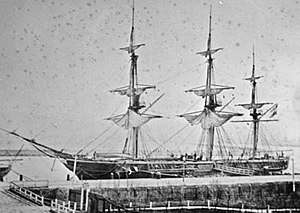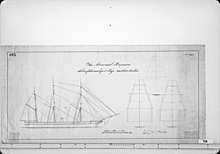Groningen-class corvette
The Groningen class was a class of steam corvettes of the Royal Netherlands Navy. The class comprised Groningen, Citadel van Antwerpen and Vice-Admiraal Koopman
 The Vice Admiraal Koopman | |
| Class overview | |
|---|---|
| Name: | Groningen class |
| Builders: | Rijkswerf Amsterdam, Fop Smit Kinderdijk |
| Operators: |
|
| Succeeded by: | Djambi-class_corvette |
| In commission: | 1857–? |
| Planned: | 3 |
| Completed: | 3 |
| Scrapped: | 3 |
| General characteristics | |
| Type: | Steam Corvette |
| Displacement: | 1,457-1,780 tons |
| Length: | 58.80 m (192 ft 11 in) |
| Beam: | 10.74 m (35 ft 3 in) |
| Draught: | 5.00 m (16 ft 5 in) |
| Installed power: |
|
| Speed: | 9 knots (17 km/h)[1] |
| Complement: | 180 |
| Armament: | 5-7 × 16 cm RML and 6 x 30 pdr Long No 2 |
| Armour: | ship made of wood |
Dutch Naval Plans in the 1850s
Dutch reaction to the Screw Steam Ship
On 8 February 1855 Smit van den Broecke became the new Dutch Secretary for the navy. At the time the Dutch were in a difficult situation. Many countries had built screw-propelled steam ships that out-sailed and out-gunned everything the Dutch navy had. The Dutch navy also required a screw propelled fleet. The reaction by Smit van den Broecke was so quick that it probably reflected plans made earlier.
Plan 1855
In May 1855 Smit van den Broecke presented an overall plan for the fleet at home and in the East Indies. The heaviest ships of the new fleet would be 3 screw steam frigates of 400 hp, 50 guns and 500 men, to be stationed in the Netherlands. The standard fighting warship for the East Indies would be a screw corvette of 250 hp, 12 30-pounders and 125 men, of which 12 would be built. For policing the many outposts in the Indies 15 sloops of 100 hp, 12 guns and 85 men would be built. These would be supplemented by small paddle ships that would navigate rivers and shallow waters.[2] The ships of the Groningen class fitted the 250 hp corvettes of this plan.
Characteristics of the Groningen class
The Groningen class was not characterized as a corvette in the 1855 plan. However, in 1857 it was generally characterized as a steam corvette (stoomkorvet) or screw corvette (schroefkorvet). Photographs and technical drawings show the class was ship-rigged. The ship displacement was also in line with that of the Royal Navy corvettes. In 1857 the class was mentioned as screw steamships of the second class (Schroefstoomschepen tweede klas), while some smaller screw ships were mentioned as screw steam ships fourth class.[3]
Design

The designed beam of the Groningen class was limited. It made for a class of rather slender and fast ships. In 1859 Tideman claimed that the stiffness of the hull of the lead ship Groningen was 'only just satisfactory'.[4] Indeed the Groningen would be declared unfit in 1863, after serving only 6 years.
The Citadel van Antwerpen was built according to the rules for calculating dimensions, weights and shapes for a steam corvette described by Tideman in his 1859 work.[5] Both the Citadel and the Koopman were significantly larger than the Groningen.
The Dutch National Archive has a lot of technical drawings of the Vice Admiraal Koopman. Technical drawings of the privately built Groningen are in the Maritime_Museum_Rotterdam
Armament
In the initial plans the armament of the Groningen class was given as 12 30-pounders. Such a vague statement was normal at a time when the armament could still change at a later time. In 1859 Tideman foresaw 4 * 30-pounder long No 1, 4 * 30-pounder long No 4 and 4 * 20 cm light grenade guns.[6]. In 1862 rifled muzzle loaders (RML) were introduced in the Dutch Navy, and being relatively modern, the class was re-armed. In 1876 the armament of the class was given as 5 (Citadel: 7) × 16 cm RML and 6 x 30-pounder Long No 2.[7] Also in 1875 there was a claim that 12 16 cm RML were required for the class[8], but it's not clear whether all guns were replaced by the 16 cm RML.
Propulsion
The Groningen class had machines of 250 nominal horsepower.[9] When the Dutch shifted to using indicated horse power, the machines were measured at 700 indicated horse power[10]. The machines for the Groningen were made by the Nederlandsche Stoombootmaatschappij in Feijenoord.[11]
Citadel van Antwerpen (ex-Dordrecht) had machines made by Van Vlissingen en Dudok van Heel this was a Penn trunk engine of 250 hp.[12] Citadel had two pairs of boilers placed back to back, capable of firing to 300 hp. Designed pressure was 15 kilogram per square inch.[13]
Names
The ships were first named Groningen, Dordrecht and Leeuwarden. The initial idea might have been to name the ships of the class for the capitals of the 11 provinces. Dordrecht was not a provincial capital, but it was the home town of Secretary for the Navy Lotsy. He had been mayor of Dordrecht before being appointed as secretary in August 1856. In June 1857 the Dordrecht and Leeuwarden were renamed on account of the 25 year remembrance of the Siege_of_Antwerp_(1832). The medal instituted on account of the siege would be part of the ornamentation of the stern of the Citadel van Antwerpen[14]
Rebuild
Both the Citadel van Antwerpen (February 1865-1869) and the Vice-Admiraal Koopman (May 1866 - 1867?) would undergo such extensive repairs that these amounted to a rebuild. This was probably the moment that the armament was changed, and one or both of the ships were lengthened.
On 2 August 1864 the Citadel van Antwerpen anchored before Flushing with a defect in the screw.[15] On 21 November 1864 the Citadel was brought into the dry-dock in Flushing for inspection.[16] The results were not good. On 19 February 1865 workmen started to tow the Citadel onto the slipway.[17] Soon after there was talk of 'very big repairs'.[18] She would stay on the slipway for more than 3 years.
On 4 July 1868 the Citadel van Antwerpen was launched a second time from the Rijkswerf in Flushing.[19] On 7 July she was brought into the drydock to be coppered.[20] On 21 August the paddle-steamer Valk arrived to bring the Citadel to Willemsoord, where she would be completed. Their departure on 26 August marked the start of the evacuation of the Rijkswerf Vlissingen. While under tow a storm hit the ships. The Citadel could not use its engine and was lucky to be blown into the harbor.[21] In September 1869 the Citadel was said to leave for Amsterdam to be finished there.[22] In July 1870 she was registered as a reserve, with 13 guns and 175 men.[23] The Citadel van Antwerpen arrived in Flushing on 14 August 1870, meaning she was finally back in service in 1870.[24]
On 23 March 1865 the Vice Admiraal Koopman arrived back in Flushing from the Dutch East Indies.[25] On 15 April 1865 the Koopman was decommissioned.[26] In mid-January the Koopman went into the dry-dock and their wer rumors of big repairs.[27] When she was brought out of the dry-dock there was only talk of a completed reparation.[28] On 4 May 1866 the Koopman was towed on the slipway in Flushing.[29] On 4 April 1867 the Koopman was launched again.[30] On 24 June 1867 the Koopman left Flushing under tow by the Valk. On board were workmen of the yard, who would be moved to Amsterdam, and also the machinery to armor ships. The Koopman was to be fitted out in Amstrerdam[31], and arrived in Nieuwediep on 30 June 1867.
Construction
Of the 3 ships 1 was built by the private yard of Fop Smit in Kinderdijk. The two others were built at the Rijkswerf in Amsterdam.
| Name | Built by | Laid down | Launched | Commissioned | Fate |
|---|---|---|---|---|---|
| Groningen | Fop Smit, Kinderdijk | 1855[32] | 9 April 1857[11] | 1 July 1857[33] | 29 September 1863 unfit[34] |
| Citadel van Antwerpen (ex Dordrecht) | Rijkswerf Amsterdam | 19 February 1856[35] | 1857[32] | 11 April 1858[36] | |
| Vice-Admiraal Koopman (ex Leeuwarden) | Rijkswerf Amsterdam | 18 October 1856[37] | 29 April 1858[38] | 6 September 1858[39] | August 1876 decommissioned[40] |
References
- Departement van Marine (1858), Koninklijke Nederlandsche Marine op den 1sten Januarij 1858, Gebroeders van Cleef
- Departement van Marine (1869), Koninklijke Nederlandsche Marine op den 1sten Januarij 1869, Gebroeders van Cleef
- Huygens, H. (1857), "De Werktuigen van Zr.Ms. Stoomschip Dordrecht", Verhandelingen en Berichten betrekkelijk het Zeewezen, De weduwe G. Hulst van Keulen, Amsterdam: 2nd part 159-177
- Tideman, B.J. (1880), Memoriaal van de Marine, Van Heteren Amsterdam
- Tideman, B.J. (1859), Verhandeling over de scheepsbouwkunde als wetenschap, Hulst van Keulen Amsterdam
- Tweede Kamer (1875), Bijlagen van het verslag der Handelingen, Nederlandsche Staatscourant
Notes
- Tweede Kamer 1875, p. Bijlage A Algemeen Overzigt der Schepen en vaartuigen van oorlog op den 1sten Augustus 1875.
- "Amsterdam, 11 Mei". De Tijd. 12 May 1858.
- "Binnenland". Algemeen Handelsblad. 2 February 1857.
- Tideman 1859, p. 2e afd p. 199.
- Tideman 1859, p. 2e afd p. 194.
- Tideman 1859, p. 2e afd p. 193.
- Tweede Kamer 1875, p. 2e afd p. 90.
- Tweede Kamer 1875, p. 2e afd p. 100.
- Tideman 1880, p. 2e afd p. 7.
- Tideman 1880, p. 2e afd p. 12.
- "Rotterdam, den 10 april". Rotterdamsche Courant. 11 April 1857.
- Huygens 1857, p. 2nd part 159.
- Huygens 1857, p. 2nd part 171.
- "Amsterdam, 16 junij". De Tijd. 18 June 1857.
- "Marine en Leger". Rotterdamsche courant. 3 August 1864.
- "Marine en Leger". Middelburgsche courant. 22 November 1864.
- "Middelburg 19 Februari". Middelburgsche courant. 19 February 1865.
- "Marine en Leger". Rotterdamsche courant. 22 February 1865.
- "Vlissingen, 4 Julij". Algemeen Handelsblad. 7 July 1868.
- "Vlissingen, 7 Julij". Algemeen Handelsblad. 10 July 1868.
- "Nieuwediep, 27 Augustus". Algemeen Handelsblad. 29 August 1868.
- "Binnenland". Utrechtsch provinciaal en stedelijk dagblad. 11 September 1869.
- "Hoofdstuk IV". De Tijd. 25 July 1870.
- "Scheepstijdingen". De Tijd. 17 August 1870.
- "Marine en Leger". Middelburgsche courant. 25 March 1865.
- "Vlissingen 16 April". Rotterdamsche courant. 20 April 1865.
- "Vlissingen, 16 Januarij". Nieuwe Rotterdamsche courant. 17 January 1866.
- "Vlissingen 30 Januarij". Rotterdamsche courant. 1 February 1866.
- "Binnenland". Algemeen Handelsblad. 7 May 1866.
- "Marine en leger". Middelburgsche courant. 6 April 1867.
- "Middelburg 24 Juni". Middelburgsche courant. 25 June 1867.
- Departement van Marine 1858, p. 84.
- "Binnenlandsche Berigten". Nederlandsche staatscourant. 24 June 1857.
- "Tweede Kamer der Staten-Generaal". Nederlandsche staatscourant. 26 September 1863.
- Departement van Marine 1869, p. 108.
- "Nieuwe Diep, 11 April". Algemeen Handelsblad. 14 April 1858.
- "Amsterdam, Zaturdag 18 October". Algemeen Handelsblad. 20 October 1856.
- "Rotterdam, 29 April". Nieuwe Rotterdamsche courant. 30 April 1858.
- "Binnenlandsche Berigten". Nederlandsche staatscourant. 15 August 1858.
- "Staatsbegrooting voor het dienstjaar 1878". 1877.